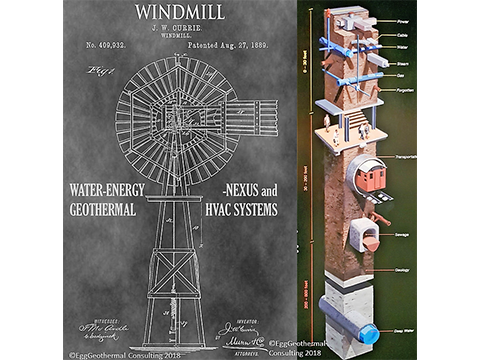The Water-Energy Nexus and Geothermal Systems
Master designed communities are using thermal energy storage and water-conserving technologies.

The water-energy nexus is a term used to describe the interdependence between water and energy in our lives. In the development of master planned communities, the water-energy nexus is front and center and has yet to realize its full potential. As an example, the U.S. Department of Energy estimates that 350 billion kilowatt-hours per year of energy paid for by its citizens goes down the drain. It is just the beginning.
In our homes, offices and buildings, we are paying to simultaneously heat and cool different areas and systems. Beyond our buildings, infrastructure processes are going on outside of the building that could easily be put to use in the water-energy nexus.
Ball State University in Muncie, Ind., completely converted from coal heating to thermal advantage energy sharing coupled to earth loops. California’s Stanford University is a recent and remarkable example of this technology. Since 1987, Stanford relied on a natural gas-fired CHP plant for virtually all its energy demand. Although efficient, its fossil-fuel-based source caused the CHP plant to produce 90 percent of Stanford’s GHG emissions and consume 25 percent of the campus’ potable water supply. As a result, Stanford’s GHG reduction strategy focused primarily on transforming the university’s energy supply through a new Central Energy Facility (CEF).
The new CEF includes three large water tanks for thermal energy storage and a high-voltage substation receiving electricity from the grid. A key feature of the CEF is an innovative heat recovery system that takes advantage of Stanford’s overlap in heating and cooling needs. In addition to the CEF, the Stanford Energy System Innovations (SESI) project converted the heat supply of all buildings from steam to hot water.
The efficiencies gained from the new CEF and hot water conversion, along with Stanford’s commitment to procure much of its electricity from solar, reduce the university’s overall GHG emissions by 68 percent from peak levels. Stanford’s Energy and Climate Plan outlines further details on the SESI project.
Water Terminology
Present-day water and energy systems are interdependent. Water is used in all phases of energy production and electricity generation. Energy is required to extract, convey and deliver water of appropriate quality for diverse human uses, and then again to treat wastewater before its return to the environment.
It's important to understand the different terminologies of water in use in our communities. Potable water is the water deemed safe for drinking. After that, water may be reclaimed and recycled, categorized and described as follows:
- Rainwater (rain caught from the roof or other direct methods of rain capture),
- Stormwater (rainwater that has reached the ground or other hard surfaces on the ground such as roads, ovals and paddocks).
- Irrigation and run-off (from sprinkler drainage, overspray and driveways).
- Greywater (from the bath, shower, basin and maybe the kitchen).
- Treated effluent (from a sewage treatment plant).
These are all alternative water supplies that are part of this effort and, when treated as required, are suitable for a range of purposes. This can include irrigating agricultural lands, in horticulture, industrial processing, in residential dual-pipe programs, and to keep our public and recreational spaces green. Also, all these water resources carry energy that may be used for the transfer and sharing of heat energy between a multitude of heating and cooling needs throughout a community.
Recycled water is a valuable resource. It contributes to the conservation of drinking water, improves the reliability of our water supplies, frees up water for the environment or growth, and reduces the amount of treated effluent discharged into our bays and oceans.
Water recycling is a generic term for water reclamation and water reuse, where the resulting water is referred to as recycled water. This term is used throughout the world but you might also find some other terms used in the water industry to describe recycled water or the process to make it, such as wastewater, reclaimed water, greywater and sewage effluent.

All may be included in thermal advantage energy sharing, which is part of the overall water-energy picture. We must focus our attention on the connections between water and energy infrastructure.
A Strategic Approach
An integrated, strategic approach can help us to address regional water-energy issues and also have national and global impacts. Enhancing and integrating data and models will better serve investors, the utilities and the public.
Six strategic “pillars” may be identified to address the water-energy nexus in communities of any size:
- Optimize the freshwater efficiency of energy production, electricity generation and end-use systems.
- Optimize the energy efficiency of water management, treatment, distribution and end-use systems.
- Enhance the reliability and resilience of energy and water systems.
- Increase safe and productive use of nontraditional water sources.
- Promote responsible energy operations concerning water quality, ecosystem and seismic impacts.
- Exploit productive synergies among water and energy systems.
In the “master design” of mixed-use communities, all facets of infrastructure must work as a single body with the purpose of facilitating interconnections of the systems. This includes thermal resources within any planned community, working as one toward the sharing of energy with any infrastructure systems within the community. A “community thermal utility” is typically regulated and empowered to charge for BTUs moved back and forth between structures and systems (at a reduced rate) set forth by the master planners.


Central heat exchangers strategically placed in master planned communities, together with timed irrigation and operation of central distribution of variable services, is a key to the successful implementation of thermal advantage in the water-energy world.
Without regard to which components are depicted on each development, consider the following systems on each project: Potable water; Sanitary sewer; Irrigation water; Greywater; Reclaimed water; Lake water; Pond and stream water; Groundwater; Home air conditioning and heating; Domestic hot water needs; Aquatic center heating and cooling needs; Commercial and office space cooling and heating needs; Public, school and government building cooling and heating needs; Retail sales and big box cooling and heating needs; Manufacturing and Industrial cooling and heating needs; and any other opportunities that may be manifest within the scope of this effort.

With all of these different components, and the desire to simplify the process, these master designed communities have opened a new frontier, helping consumers and professionals to use available energy as part of the water-energy nexus.
As a follow up on the Stanford Project, Joseph Stagner shared that they have designed and field-tested a geothermal heat exchanger addition for those loads outside of the balance shared. The research team also is finishing a lake water heat exchange system design that looks promising for them; Stagner believes Stanford will likely proceed with the surface water exchange to fully eliminate gas use in its district energy system.

Special thanks to Joseph Stagner, P.E., executive director, Department of Sustainability and Energy Management, Stanford University, Stanford, Calif. Image credits to ZGF/Robert Canfield, Whiting-Turner, AEI, Stanford University and EggGeothermal.





